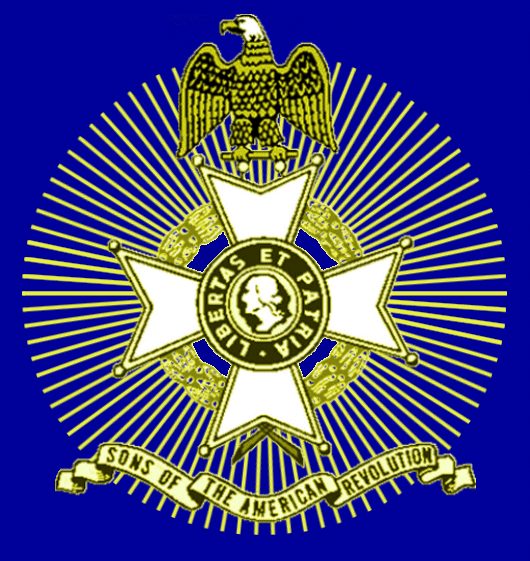Revolutionary Service of General Rezin Beall
by Ward Ginn
Fairfax Resolves Chapter
Sons of the American Revolution
Delivered at a Veteran’s Day Ceremony and Grave Marking
St. John’s Episcopal Church
Beltsville, Maryland
November 9, 2002
We are here on this Veteran’s Day to honor a soldier of the American Revolution affectionately known by many of the men who served under him as “The Little Iron Man.” May the bronze marker we leave today be a reminder of the gallant service of General Rezin Beall to his country during the American Revolution. I am especially proud to be here today because one of my patriot ancestors, Thaddeus Beall was General Beall’s Brigade Major.
Thirty-three years ago on an icy cold and bleak day in November, the remains of General Beall were removed from his original resting place in the family plot on his plantation, a short distance from here, and reentered in the ground before us. Responsible for the relocation in 1969 of the General’s grave were the owners of the farmland on which the General’s grave was first cited, the vestry of St. John’s Episcopal Church, the Prince Georges County Historical Society and the General Rezin Beall Chapter of the Daughters of the American Revolution. According to the Centennial edition of the DAR Patriot Index, Rezin Beall was the highest ranking of the some 250 Bells to serve their country in the American Revolution.
Rezin Beall was born around 1723, the son of William Beall, who, in turn, was the son of Thomas Beall, one of the five Bealls who immigrated from Scotland to Maryland in the late 1660s. Rezin’s first wife, Amelia Beall, was the great grand-daughter of Ninian Beall, the immigrant who gained fame for commanding the militia in Maryland, founding the Presbyterian Church in America and having vast land holdings, including the land on which the White House stands today.
Little is known of Rezin Beall’s private life. It is said that he was an excellent violinist and contemporary accounts of his life tell that he was a controversial character. He is best known as a soldier and hero. He started his military career by enlisting as a private in Captain Ware’s Company in the French and Indian War of 1757-8. Beall was later commissioned in Ware’s unit as a Second Lieutenant. On January 2, 1776, Beall was commissioned Captain of the First Independent Company of the Maryland Regulars.
Six months later on July 17, 1776, Captain Beall was wounded in an engagement with British ships at St. Georges in St. Mary’s County, Maryland. Two days later, on July 19, he was wounded again while engaged with British ships on the St. Charles River.
An account of Captain Beall’s heroism is provided by Lieut.-Colonel Fielder M.M. Beall in his anthology of Beall genealogy Colonial Families of the United States Descended from the Emmigrants Bell, Beal, Bale, Beale and Beall:
“Captain Beall’s outlook had warned him before
dawn of the arriving ships. He deployed his
100 men in a thin line along the coast in the
bushes opposite the ships, with orders that if the
enemy tried to come ashore they would not fire
until their boats were 25 yards from the shore.
Each ship filled a boat with armed men and
were soon moving toward the shore. The firing of
Captain Rezin’s men was such a surprise that the
boats were thrown into confusion, and many of
Captain Beall’s men got in a second shot before
their fire was returned by the British.
The enemy did not attempt to land, but returned
to their ships and indulged in vigorous big-gun fire.
This fire killed and wounded a number of
men, wounding Captain Beall in the hip.
This remarkable act of repulsing 80 enemy
sail with 100 men prompted Captain Beall’s friends
to confer on him the title of The Little Iron Man.”
The success of this action was not overlooked because at Annapolis, on August 23, 1776, Captain Rezin Beall was commissioned Brigadier General by the Council of Safety. Two weeks later on September 6, 1776, General Beall’s Brigade of the Maryland Flying Camp distinguished themselves at the Battle of Harlem. Only two weeks later on September 21, 1776, General Beall’s Brigade, consisting of four regiments, displayed “great nerve and steadiness” at the Battle of White Plains.
On December 19, 1776, General Beall’s commission expired. Although several months had passed since his confrontation with the British at St. Georges Island, the wound that Beall suffered in that action had not healed. On account of the unhealed wound, Beall opted to take a leave of absence from further military duty in order to convalesce. Nearly two years later, Rezin Beall was commissioned Lieut. Colonel in the Middle Battalion Prince Georges County Militia.
It is said that in tribute to General Beall, a great number of troops that served under him named their first-born sons after their wartime commander. There are some that also believe that by repulsing the British at St. Georges “The Little Iron Man” should be given full credit that there are no Revolutionary War battlefields on Maryland soil.
Following the Revolution, Beall retired to his plantation near Beltsville called Turkey Flight Farm (or Plantation) where he lived until his death on October 14, 1809. He was buried in the family plot on the farm. In the years that followed, his descendants moved out of the area, and Rezin Beall’s name and role in the Revolutionary War were nearly forgotten.
Thanks to those responsible for its relocation, Rezin Beall’s gravestone stands today on protected ground in this church yard, memorializing “The Little Iron Man” whose remains were returned to the soil he once loved and protected in a different time.
“May the ‘The Little Iron Man’ rest in peace.”
![]()
General Rezin Beall Grave Marker

General Rezin Beall Grave Marker
Photo courtesy of Find A Grave (visit for more pictures)

